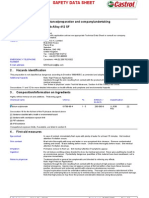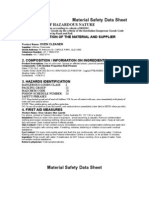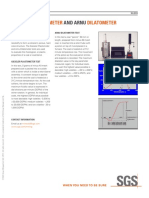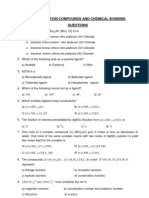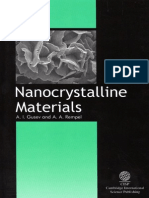Zinc Oxide (Umicore)
Zinc Oxide (Umicore)
Uploaded by
Ita SupriatinCopyright:
Available Formats
Zinc Oxide (Umicore)
Zinc Oxide (Umicore)
Uploaded by
Ita SupriatinOriginal Description:
Copyright
Available Formats
Share this document
Did you find this document useful?
Is this content inappropriate?
Copyright:
Available Formats
Zinc Oxide (Umicore)
Zinc Oxide (Umicore)
Uploaded by
Ita SupriatinCopyright:
Available Formats
Zinc Chemicals
MATERIAL SAFETY DATA SHEET
Zinc Oxide
1. Identification of the substance/preparation and of the
company/undertaking
Identification of the substance or preparation
Product name
: Zinc Oxide
Common/Trade name
: Red Seal, White Seal, Pharmaceutical, BP
Use of the
: Industrial applications: Production of rubber. Production of tyres. Varistors.
substance/preparation
Ceramics. Glass. Manufacture of chemicals. Manufacture of Lubricants.
Agricultural industry Ferrites. Manufacture of cosmetics. Veterinary Product.
Pharmaceuticals. Plastics. Glues. Pigments to paint and printing inks. Enamels.
Company/undertaking identification
Supplier
Umicore Australia Limited
414 Somerville Road,
Tottenham, Victoria, 3012
Australia
Telephone : (+613) 9362 6500
Emergency telephone
:
(+613) 9362 6500 (during Business Hours)
This product is not classified as hazardous according to criteria of NOHSC.
This product is not classified as a dangerous good according to the Australian Dangerous Goods code.
2. Composition/information on ingredients
Substance/preparation : Substance
Ingredient name
zinc oxide
CAS number
1314-13-2
%
>99
EC number
215-222-5
Classification
N; R50/53
See section 16 for the full text of the R
Phrases declared above
*Occupational Exposure Limit(s), if available, are listed in section 8
3. Hazards identification
The preparation is classified as dangerous according to Directive 67/548/EEC and its amendments.
Classification
: N; R50/53
Environmental
: Very toxic to aquatic organisms. May cause long-term adverse effects in the aquatic
hazards
environment.
See section 11 for more detailed information on health effects and symptoms
Version 4 October 2005
Umicore Australia Limited
A.B.N. 12 008 638 917
414 Somerville Rd,
Tottenham, Victoria, 3012, Australia
www.zincchemicals.umicore.com
Zinc Oxide
Page : 1/6
Tel +613-9362 6500
PO Box 6867 Marion Square
Fax + 613-9362 6555
Wellington, New Zealand
email:contact.australia@umicore.com NZ Toll Free 0800 314 047
4. First aid measures
Symptoms
Inhalation
Ingestion
Skin contact
Eye contact
First aid measures
Inhalation
: No known significant effects or critical hazards.
: No known significant effects or critical hazards.
: No known significant effects or critical hazards.
: No known significant effects or critical hazards.
: If inhaled, remove to fresh air. If breathing is difficult, give oxygen. If not
breathing, give artificial respiration. Obtain medical attention.
Ingestion
: Do NOT induce vomiting unless directed to do so by medical personnel. Never
give anything by mouth to an unconscious person. If large quantities of this
material are swallowed, call a physician immediately.
Skin contact
: In case of contact, immediately flush skin with plenty of water. Remove
contaminated clothing and shoes. Wash clothing before reuse. Thoroughly clean
shoes before reuse. Get medical attention if irritation occurs.
Eye contact
: In case of contact, immediately flush eyes with plenty of water for at least 15
minutes. Get medical attention.
See section 11 for more detailed information on health effects and symptoms.
5. Fire-fighting measures
Extinguishing media
Special exposure
hazards
Special protective
equipment for firef
i
g
ht
e
r
s
: Use an extinguishing agent suitable for surrounding fires.
: No specific hazard.
This material is very toxic to aquatic organisms. Fire water contaminated with
this material must be contained and prevented from being discharged to any
waterway, sewer or drain.
See section11 for more detailed information on health effects and symptoms.
: Fire fighters should wear appropriate protective equipment and self-contained
breathing apparatus (SCBA) with a full facepiece operated in positive pressure
mode.
6. Accidental release measures
: Immediately contact emergency personnel. Keep unnecessary personnel away.
Use suitable protective equipment (Section 8).
Environmental precautions : Avoid dispersal of spilled material and runoff and contact with soil, waterways,
drains and sewers.
Methods for cleaning up
: If emergency personnel are unavailable vacuum or carefully scoop up spilled
materials and place in an appropriate container for disposal. Avoid creating dusty
conditions and prevent wind dispersal.
Note: see section 8 for personal protective equipment and section 13 for waste disposal.
Personal precautions
7. Handling and storage
Handling
Storage
Additional Information
Packaging materials
Recommended
: Avoid contact of spilled material and runoff with soil and surface waterways.
: Keep container closed tightly. Keep container in a well-ventilated area.
: Keep away from acids and alkalis.
: Use original container.
Version 4 October 2005
Zinc Oxide
Page : 2/6
8. Exposure controls/personal protection
Ingredient name
zinc oxide
Exposure controls
Occupational
exposure controls
Respiratory
protection
Skin protection/
Hand protection
Eye protection
Hygiene measures
General
Occupational exposure limits
EH40-OES (United Kingdom (UK), 5/2003).
STEL: 10mg/m 15 minutes. Form: Fume
TWA: 5 mg/m 8 hours. Form: Fume
: Use process enclosures, local exhaust ventilation, or other engineering controls
to keep airborne levels below recommended exposure limits. If user operations
generate dust, fume or mist, use ventilation to keep exposure to airborne
contaminants below the exposure limit.
: Use a properly fitted, particulate filter respirator complying with an approved
standard if a risk assessment indicates this is necessary. Respirator selection
must be based on known or anticipated exposure levels, the hazards of the
product and the safe working limits of the selected respirator.
: Chemical-resistant, impervious gloves or gauntlets complying with an approved
standard should be worn at all times when handling chemical products if a risk
assessment indicates this is necessary.
Personal protective equipment for the body should be selected based on the task
being performed and the risks involved and should be approved by a specialist
before handling this product.
: Safety eyewear complying with an approved standard should be used when a
risk assessment indicates this is necessary to avoid exposure to liquid splashes,
mists or dusts.
Eating, drinking and smoking should be prohibited in area where this material is
handled, stored and processed. Workers should wash hands and face before
eating, drinking and smoking.
9. Physical and chemical properties
General information
Appearance
Physical state
: Solid. (Solid powder)
Color
: White.
Odor
: Odourless.
Important health, safety and environmental information
pH
: Not applicable.
Melting point
: Sublimation Temperature: 1975C (3587F)
Flash point
: Not applicable.
Explosive properties
: Not considered as a product presenting risks of explosion.
Oxidizing properties
: Not applicable.
Relative Density
: 5.61 (Water = 1)
Solubility
: Insoluble in cold water.
10. Stability and reactivity
Stability
Materials to avoid
: The product is stable.
: Reactive with acids, alkalis.
Keep away from acids and alkalis.
Version 4 October 2005
Zinc Oxide
Page : 3/6
11. Toxicological information
Potential acute health effects
Inhalation
: No known significant effects or critical hazards.
Ingestion
: No known significant effects or critical hazards.
Skin contact
: No known significant effects or critical hazards.
Eye contact
: No known significant effects or critical hazards.
Acute toxicity
Ingredient name
zinc oxide
Test
LD50
LDLo
LDLo
LD50
Result
7950mg/kg
>2000mg /kg
500mg/kg
>5700 mg/m
(4 hours)
Route
Oral
Dermal
Oral
Inhalation
Species
Mouse
Rat
Human
Rat [Klimisch et al. 1982]
Potential chronic health effects
Carcinogenicity
: No known significant effects or critical hazards.
Classified A4 (Not classifiable for human or animal.) by ACGIH [zinc oxide]
Mutagenicity
: No known significant effects or critical hazards.
Reproductive
: No known significant effects or critical hazards.
Toxicity
12. Ecological information
Ecotoxicity data
Ingredient name
zinc oxide
Other adverse effects
Species
Daphnia magna (EC50)
Oncorhynchus mykiss
(LC50)
Lepomis macrochirus
(LC50)
Pimephales promelas
(LC50)
Selenastrum
Capricornutum.[Lisec
1997] (EC50)
Period
48 hours
96hours
Result
>1000 mg/l
1.1mg/l
96 hours
>320 mg/l
96 hours
2246 mg/l
72 hours
0.17 mg/l
: Very toxic to aquatic organisms. May cause long-term adverse effects in the
aquatic environment.
13. Disposal considerations
Methods of disposal
European waste
catalogue (EWC)
Hazardous waste
: The generation of waste should be avoided or minimized wherever possible.
Avoid dispersal or spilled material and runoff and contact with soil, waterways,
drains and sewers. Disposal of this product, solutions and any by-products
should at all times comply with the requirements of environmental protection
and waste disposal legislation and any regional local authority requirements.
This product is recyclable. Consideration of disposal via this route should be
given.
: Not available.
Version 4 October 2005
: The classification of the product may meet the criteria for a hazardous waste.
Zinc Oxide
Page : 4/6
14. Transport information
International transport regulations
Regulatory
information
ADR/RID
Classification
UN number
Proper shipping name
Class
UN3077
Environmentally hazardous
substance, solid, n.o.s.
(zinc oxide)
Packing
group
III
Label
Additional
information
ADN Classification
UN3077
Environmentally hazardous
substance, solid, n.o.s.
(zinc oxide)
III
IMO/IMDG
Classification
IATA Class
Not
regulated.
Not
regulated.
Hazard
identification
number
90
Limited quantity
LQ27
CEFIC Tremcard
90GM7-III
15. Regulatory information
EU Regulations
Hazard symbol(s)
Dangerous for the environment.
: R50/53 Very toxic to aquatic organisms, may cause long-term adverse effects
in the aquatic environment.
Safety phrases
: S60 - This material and its container must be disposed of as hazardous waste.
S61 Avoid release to the environment. Refer to special instructions/ Safety
data sheets.
Product use
: Classification and labeling have been performed according to EU directives
67/548/EEC, 1999/45/EC including amendments and the intended use.
- Industrial applications.
Conforms to 91/155/EEC 2001/58/EC United Kindom (UK)
Risk Phrases
Version 4 October 2005
Zinc Oxide
Page : 5/6
16. Other information
Full text of R phrases
: R50/53 Very toxic to aquatic organisms, may cause long-term adverse effects
referred to in sections 2 in the aquatic environment.
and 3 United
Kingdom (UK)
Full text of
: N Dangerous for the environment.
classifications referred
to in sections 2 and 3
United Kingdom (UK)
NOTE
: All R phrases and their applications have recently been adopted by the
European Commission. This Material Safety Data Sheet has been adapted
for Umicore Australia Limited.
History
Date of issue
: October, 2005.
Date of previous issue : October, 2001.
Version
:4
Notice to reader
To the best of our knowledge, the information contained in this Material Safety Data Sheet is accurate and
reliable on presently available resources. However, neither the seller nor any of its subsidiaries assumes
any responsibility or liability whatsoever for the accuracy or completeness of the information contained
herein.
This Material Safety Data Sheet shall not constitute a guarantee for any specific product features. Final
determination of suitability of this material is the sole responsibility of the user.
All materials may present unknown hazards and should be used and handled with caution and following
reasonable safety procedures. Consequently the buyer assumes all risks in connection with the use and
handling of this material.
Version 4 October 2005
Zinc Oxide
Page : 6/6
You might also like
- The Health & Safety Guide for Film, TV & Theater, Second EditionFrom EverandThe Health & Safety Guide for Film, TV & Theater, Second EditionRating: 4 out of 5 stars4/5 (1)
- Msds Pig IronDocument6 pagesMsds Pig Ironcampag12350% (2)
- Sikabond NV MsdsDocument5 pagesSikabond NV Msdsudadaripaddang100% (1)
- SDS Conplast WP400 IndiaDocument3 pagesSDS Conplast WP400 Indiameor azrieNo ratings yet
- Hydro X Boiler TreatmentDocument5 pagesHydro X Boiler TreatmentZoran ObradovicNo ratings yet
- 1 - Identification of The Substance/preparation and Company/undertaking Molub-Alloy 412 SFDocument4 pages1 - Identification of The Substance/preparation and Company/undertaking Molub-Alloy 412 SFwillowwood666No ratings yet
- MSDS Sodium CarbonateDocument6 pagesMSDS Sodium CarbonateEndang SupriyatnaNo ratings yet
- SikaRail KC 340 - 45Document12 pagesSikaRail KC 340 - 45MikeNo ratings yet
- SDS - WaterFine ZN Primer - Comp. B - Marine - Protective - enDocument5 pagesSDS - WaterFine ZN Primer - Comp. B - Marine - Protective - enAndres Fitria FarrelNo ratings yet
- Msds Codex 661 - Rev-01MSDS CODEX 661Document6 pagesMsds Codex 661 - Rev-01MSDS CODEX 661manlekNo ratings yet
- Safety Data Sheet Dated 16/10/2008, Version 6, #3548Document4 pagesSafety Data Sheet Dated 16/10/2008, Version 6, #3548titus gurningNo ratings yet
- 2013 01 Cumene Hydroperoxide Aldrich MSDSDocument7 pages2013 01 Cumene Hydroperoxide Aldrich MSDStpr314No ratings yet
- CHEMICOOLDocument6 pagesCHEMICOOLRoslinaNo ratings yet
- MSDS SPN 80 - PT Tritunggal ArthamakmurDocument8 pagesMSDS SPN 80 - PT Tritunggal ArthamakmurSeftia NurfaNo ratings yet
- Industrial Cleansers Pty LTD: Material Safety Data SheetDocument7 pagesIndustrial Cleansers Pty LTD: Material Safety Data SheetBruce HeathNo ratings yet
- Actellic 50 EcDocument9 pagesActellic 50 Ecnadi1onlyNo ratings yet
- Msds St-Aca English 2023Document7 pagesMsds St-Aca English 2023danghoangtube002No ratings yet
- 2,3,5 Triphenyl 2H Tetrazolium ChlorideDocument4 pages2,3,5 Triphenyl 2H Tetrazolium Chloridecowpea2009No ratings yet
- Msds-Durocon 650Document4 pagesMsds-Durocon 650Ankita Baban GavadeNo ratings yet
- Material Safety Data Sheet Castor Oil BlownDocument7 pagesMaterial Safety Data Sheet Castor Oil BlownadliazharuddinNo ratings yet
- Hydrotite Adhesive SDS-GreenstreakDocument13 pagesHydrotite Adhesive SDS-Greenstreakrobox514No ratings yet
- Premise 200 SC Termiticide PDF 37kbDocument8 pagesPremise 200 SC Termiticide PDF 37kbMYUTILITYNo ratings yet
- Material Safety Data Sheet of OXALIC ACIDDocument5 pagesMaterial Safety Data Sheet of OXALIC ACIDtradeasiagroupNo ratings yet
- Safety Data Sheet: Identification of The Substance/Preparation and of The Company/Undertaking 1Document13 pagesSafety Data Sheet: Identification of The Substance/Preparation and of The Company/Undertaking 1Chan Shiaw SyanNo ratings yet
- Lithium Hydroxide MonohydrateDocument6 pagesLithium Hydroxide MonohydratemeimeiliuNo ratings yet
- Ghs Calcium Glycerophosphate MsdsDocument6 pagesGhs Calcium Glycerophosphate MsdsSRI VYJAYANTHI QANo ratings yet
- Safety Data Sheet: Section 1. IdentificationDocument7 pagesSafety Data Sheet: Section 1. IdentificationBehnam NoorizadehNo ratings yet
- SDS - WaterFine Acrylic Primer - Marine - Protective - EnglishDocument5 pagesSDS - WaterFine Acrylic Primer - Marine - Protective - EnglishAndres Fitria FarrelNo ratings yet
- 65 Disinfecting Heavy Duty Acid Bathroom CleanerDocument5 pages65 Disinfecting Heavy Duty Acid Bathroom CleanerDaniel GrissoNo ratings yet
- SDS - Waterfine ZN Primer - Comp. A - Marine - Protective - enDocument4 pagesSDS - Waterfine ZN Primer - Comp. A - Marine - Protective - enAndres Fitria FarrelNo ratings yet
- All Purpose Thinner Sep11Document4 pagesAll Purpose Thinner Sep11Paul De ChaufepieNo ratings yet
- Safety Data Sheet: Identification of The Substance/preparation and of The Company/undertakingDocument4 pagesSafety Data Sheet: Identification of The Substance/preparation and of The Company/undertakingBalasubramanian AnanthNo ratings yet
- Na HSO3Document8 pagesNa HSO3Bao Duy NguyenNo ratings yet
- Hypogear 80W-90 - BP Australia Pty LTDDocument5 pagesHypogear 80W-90 - BP Australia Pty LTDBiju_PottayilNo ratings yet
- Material Safety Data Sheet: Shandong Aona Chemical Co.,LtdDocument7 pagesMaterial Safety Data Sheet: Shandong Aona Chemical Co.,Ltddalton2003No ratings yet
- Material Safety Data Sheet: Poly Aluminium ChlorideDocument4 pagesMaterial Safety Data Sheet: Poly Aluminium ChlorideKusmianti DeoraNo ratings yet
- Safety Data Sheet According To (EC) No 1907/2006 - ISO 11014-1Document5 pagesSafety Data Sheet According To (EC) No 1907/2006 - ISO 11014-1Ahmed Emad AhmedNo ratings yet
- MSDS Diaclean Pera Sterilant Peroxyacetic Acid April 2020 LatestDocument4 pagesMSDS Diaclean Pera Sterilant Peroxyacetic Acid April 2020 LatestArif Amin100% (1)
- Ardrox 3968 MSDSDocument11 pagesArdrox 3968 MSDSlubangjarumNo ratings yet
- Carbodur MSDSDocument5 pagesCarbodur MSDSAbrahim KazzazNo ratings yet
- Fluosilicic - Acid.hydrofluosilicic PIVOTDocument5 pagesFluosilicic - Acid.hydrofluosilicic PIVOTVYSUPER6No ratings yet
- Bayer Gaucho600 Material Safety Datasheet 6pagesDocument6 pagesBayer Gaucho600 Material Safety Datasheet 6pagesjs4scribdNo ratings yet
- SikaCem Concentrate - MSDSDocument5 pagesSikaCem Concentrate - MSDSLou Melvin CruzNo ratings yet
- MSDS Sodium ChlorideDocument6 pagesMSDS Sodium ChlorideEndang SupriyatnaNo ratings yet
- MATERIAL SAFETY DATA SHEET (Ethylenedinitrilo) Tetraacetic AcidDocument5 pagesMATERIAL SAFETY DATA SHEET (Ethylenedinitrilo) Tetraacetic AcidmisterpokeNo ratings yet
- Msds CP4020 000Document4 pagesMsds CP4020 000johnsopranaNo ratings yet
- MSDS Oven Cleaner Caustic Commercial GradeDocument4 pagesMSDS Oven Cleaner Caustic Commercial GradeyakazeNo ratings yet
- Safety Data Sheet Ether, Anhydrous: Section 1 Product DescriptionDocument4 pagesSafety Data Sheet Ether, Anhydrous: Section 1 Product DescriptionSilvi TatianNo ratings yet
- Micro Matrix Cement RetarderDocument6 pagesMicro Matrix Cement Retarderadvantage025No ratings yet
- MSDS CuvetteConditionerEX-dikonversiDocument4 pagesMSDS CuvetteConditionerEX-dikonversiidatarraNo ratings yet
- Hitide 2i (BP)Document4 pagesHitide 2i (BP)Biju_PottayilNo ratings yet
- Material Safety Data Sheet: Wonder Gel™ Stainless Steel Pickling GelDocument2 pagesMaterial Safety Data Sheet: Wonder Gel™ Stainless Steel Pickling GelTrần Thùy LinhNo ratings yet
- Ec 54NFDocument4 pagesEc 54NFtitus gurningNo ratings yet
- Safety Data Sheet: Xtex Pty. LTD ABN 40 121 722 236 3 Kiln Street Malaga, WA 6090 1300-00-9839 Phone 0437-272-490 MobileDocument5 pagesSafety Data Sheet: Xtex Pty. LTD ABN 40 121 722 236 3 Kiln Street Malaga, WA 6090 1300-00-9839 Phone 0437-272-490 Mobiledwalding9956No ratings yet
- MSDS Tanah ElektrolitDocument5 pagesMSDS Tanah ElektrolitBayu HidayatNo ratings yet
- Hoja Seguridad SikaboomDocument6 pagesHoja Seguridad SikaboomcristhianNo ratings yet
- MSDS Ore Dressing AgentDocument6 pagesMSDS Ore Dressing AgentUrantuul dashNo ratings yet
- EthylacetateDocument5 pagesEthylacetateA.Magied MahmoudNo ratings yet
- MSDS Nitric AcidDocument7 pagesMSDS Nitric AcidDiah DarmawanNo ratings yet
- XLL - Project - AdsorptionDocument12 pagesXLL - Project - AdsorptionxxxNo ratings yet
- Class 11 ChemistryDocument3 pagesClass 11 Chemistrymanishsrivastava6911No ratings yet
- Concentration of SolutionsDocument15 pagesConcentration of SolutionsAnonymous 9uu04elNo ratings yet
- 1412finalsample KeyDocument18 pages1412finalsample KeyErnesto Tarroza Yap Jr.No ratings yet
- Technical Specifications: Duct Work and Outlets GeneralDocument16 pagesTechnical Specifications: Duct Work and Outlets GeneralNedunuri.Madhav MurthyNo ratings yet
- Heat Exchangers: The Effectiveness - NTU Method: Sections 11.4 Through 11.7Document15 pagesHeat Exchangers: The Effectiveness - NTU Method: Sections 11.4 Through 11.7Joli SmithNo ratings yet
- Failure Analysis ProcedureDocument9 pagesFailure Analysis ProcedureDaniel RomeroNo ratings yet
- SGS MIN WA295 Met Coal Gieseler Plastometer and Arnu Dilatometer en 11Document1 pageSGS MIN WA295 Met Coal Gieseler Plastometer and Arnu Dilatometer en 11hasbiNo ratings yet
- Grating BrochureDocument36 pagesGrating BrochureJasperTanNo ratings yet
- Cytogenetic Slide PreparationDocument9 pagesCytogenetic Slide PreparationRicardo PalmaNo ratings yet
- Effect of Pregelatinized Corn and Rice Flour On Specific Volume of Gluten-Free Traditional Algerian Bread Khobzeddar Using Central Composite DesignDocument11 pagesEffect of Pregelatinized Corn and Rice Flour On Specific Volume of Gluten-Free Traditional Algerian Bread Khobzeddar Using Central Composite DesignHadi Yusuf FaturochmanNo ratings yet
- Kinetics PretestDocument4 pagesKinetics PretestAngeline SmithNo ratings yet
- CH # 7 Separator & Slug CatcherDocument15 pagesCH # 7 Separator & Slug CatcherMuhammad Zeeshan Wasi100% (1)
- Introduction To Piping Systems: CM4110 Unit Operations LabDocument31 pagesIntroduction To Piping Systems: CM4110 Unit Operations LabarminalizadehNo ratings yet
- Engineering Design Guideline Control Valve Rev 6Document20 pagesEngineering Design Guideline Control Valve Rev 6ask_friend50% (4)
- Gibbs1875-1878-Equilibrium of Heterogeneous Substances PDFDocument329 pagesGibbs1875-1878-Equilibrium of Heterogeneous Substances PDFRichard SmithNo ratings yet
- Chemistry Investigatory Project XII On Toothpaste Analysis - PDF - Ion - Salt (Chemistry)Document47 pagesChemistry Investigatory Project XII On Toothpaste Analysis - PDF - Ion - Salt (Chemistry)Valli RamalingamNo ratings yet
- Partition Function of 1-, 2-, and 3-D Monatomic Ideal Gas: A Simple and Comprehensive ReviewDocument4 pagesPartition Function of 1-, 2-, and 3-D Monatomic Ideal Gas: A Simple and Comprehensive ReviewiremdemirkanNo ratings yet
- 215215Document5 pages215215Chandan V ChanduNo ratings yet
- Paint Master Universal Undercoat - SDSDocument3 pagesPaint Master Universal Undercoat - SDSMichael JoudalNo ratings yet
- 12 Science Holiday HomeworkDocument20 pages12 Science Holiday HomeworkAziyaNo ratings yet
- YOGA ManualDocument9 pagesYOGA Manual12mchc07No ratings yet
- Fractionation Column CalculationDocument29 pagesFractionation Column Calculationsyamsudin2006100% (1)
- B.3.3 Plastic Parts With Integrally Molded Threads, FarbigDocument26 pagesB.3.3 Plastic Parts With Integrally Molded Threads, FarbigVasil GospodinovNo ratings yet
- Anexo HidrocicloneDocument14 pagesAnexo HidrocicloneMayke Cezar WippelNo ratings yet
- Assessment and Determination of Optimum Concentration of Streptomycin and Kanamycin As Selective Agents in Peppermint (MenthaDocument6 pagesAssessment and Determination of Optimum Concentration of Streptomycin and Kanamycin As Selective Agents in Peppermint (MenthaMonaia YehiaNo ratings yet
- Defluoridation of Groundwater Using Brickpowder and Lemon LeafDocument13 pagesDefluoridation of Groundwater Using Brickpowder and Lemon Leafsx developerNo ratings yet
- NANO Book 1 PDFDocument357 pagesNANO Book 1 PDFVaibhav100% (1)
- Drilling Engineering DrillstringDocument45 pagesDrilling Engineering DrillstringMuhammad NursalamNo ratings yet
- Nashi Argan Essential Energy 2022Document30 pagesNashi Argan Essential Energy 2022ramyNo ratings yet





